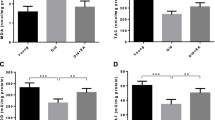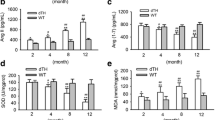Abstract
Angiotensin II (Ang II), a main effector of the renin-angiotensin system, is recognized as a pro-inflammatory mediator on age-related vascular inflammation. Ang II is one of the most important oxidative stress inducer, activates the redox-sensitive transcription factor, nuclear factor-κB (NF-κB) during aging. Genistein, a major component found in isoflavone, has anti-inflammatory activities that are often associated with its anti-oxidative activity. The purpose of this study is to document molecular mechanism of altered Ang II-related NF-κB activation during aging and inhibitory molecular events by genistein regarding to age-related Ang II-induced NF-κB activation. At present, we utilized young (6 months old), old (24 months old), and genistein-treated (2 and 4 mg/kg/day for 10 days) old rats. For our current study, we choose to use the kidney and rat endothelial cell line, YPEN-1 because of its vulnerability to age-related oxidative stress and inflammatory responsiveness. The results of the analysis showed that Ang II and AT1 expression increased during aging and that these increases were blunted by treatment with genistein. Furthermore, we investigated the inhibitory effects of genistein on the Ang II-induced redox imbalance in aged rat kidneys. Genistein reduced age-related increases in NF-κB activity and NF-κB-dependent pro-inflammatory genes expression. We also determined genistein attenuated Ang II-induced NF-κB activation through its anti-oxidant activity in YPEN-1 cells. Taken together, our present results show that genistein has potent anti-inflammatory effect resulting in the attenuation of the Ang II-induced NF-κB activation during aging. The most significant new finding from this study is that genistein exerts its anti-Ang II action during aging by suppressive effect of NF-κB activation. Based on these data, genistein may be an anti-Ang II agent that may be used in anti-inflammatory therapies.








Similar content being viewed by others
References
Alhasan SA, Ensley JF, Sarkar FH (2000) Genistein induced molecular changes in a squamous cell carcinoma of the head and neck cell line. Int J Oncol 16:333–338
Anderson S, Meyer TW, Rennke HG, Brenner BM (1996) Control of glomerular a hypertension limits glomerular injury in rats with reduced renal mass. J Clin Invest 76:612–619
Basso N, Paglia N, Stella I, de Cavanagh EM, Ferder L, Arnaiz M, Inserra F (2005) Protective effect of the inhibition of the renin-angiotensin system on aging. Regul Pept 128:247–252
Benigni A, Corna D, Zoja C, Sonzogni A, Latini R, Salio M, Conti S, Rottoli D, Longaretti L, Cassis P, Morigi M, Coffman T, Remuzzi G (2009) Disruption of the Ang II type 1 receptor promotes longevity in mice. J Clin Invest 119:524–530
Benigni A, Cassis P, Remuzzi G (2010) Angiotensin II revisited: new roles in inflammation, immunology and aging. EMBO 2:247–257
Carey RM (2007) Angiotensin receptors and aging. Hypertension 50:33–34
Cassis P, Conti S, Remuzzi G, Benigni A (2010) Angiotensin receptors as determinants of life span. Pflugers Archiv Eur J Physiol 459:325–332
Chai W, Danser A (2005) Is angiotensin II made inside or outside of the cell? Curr Hypertens Rep 7:124–127
Cheng ZJ, Vapaatalo H, Mervaala E (2005) Angiotensin II and vascular inflammation. Med Sci Monit 11:194–205
Chung HY, Kim HJ, Kim KW, Choi JS, Yu BP (2002) Molecular inflammation hypothesis of aging based on the anti-aging mechanism of calorie restriction. Microsc Res Tech 59:264–272
Chung HY, Sung B, Jung KJ, Zou Y, Yu BP (2006) The molecular inflammatory process in aging. Antioxid Redox Signal 8:572–581
Chung HY, Cesari M, Anton S, Marzetti E, Giovannini S, Seo AY, Carter C, Yu BP, Leeuwenburgh C (2009) Molecular inflammation: underpinnings of aging and age-related diseases. Ageing Res Rev 8:18–30
da Silva Lemos M, Nardoni Gonçalves Braga A, Roberto da Silva J, Augusto Souza Dos Santos R (2005) Altered cardiovascular responses to chronic angiotensin II infusion in aged rats. Regul Pept 132:67–73
Davis JN, Kucuk O, Sarkar FH (1999) Genistein inhibits NF-kappa B activation in prostate cancer cells. Nutr Cancer 35:167–174
Diz D (2008) Lewis K. Dahl memorial lecture: the renin-angiotensin system and aging. Hypertension 52:37–43
Farzamirad V, Aluko RE (2008) Angiotensin-converting enzyme inhibition and free-radical scavenging properties of cationic peptides derived from soybean protein hydrolysates. Int J Food Sci Nutr 59:428–437
Griendling KK, Minieri CA, Ollerenshaw ZD, Alexander RW (1994) Angiotensin II stimulates NADH and NADPH oxidase activity in cultured vascular smooth muscle cells. Circ Res 74:1141–1148
Harman D (1973) Free radical theory of aging. Triangle 12:153–158
Hoffmann A, Levchenko A, Scott ML, Baltimore D (2002) The IκB NF-κB signaling module: temporal control and selective gene activation. Science 298:1241–1245
Inserra F, Basso N, Ferder M, Userpater M, Stella I, Paglia N, Inserra P, Tenembaum D, Ferder L (2009) Changes seen in the aging kidney and the effect of blocking the renin-angiotensin system. Ther Adv Cardiovasc Dis 3:341–346
Ito N, Ohishi M, Yamamoto K, Tatara Y, Shiota A, Hayashi N, Komai N, Yanagitani Y, Rakugi H, Ogihara T (2007) Renin-angiotensin inhibition reverses advanced cardiac remodeling in aging spontaneously hypertensive rats. Am J Hypertens 20:792–799
Kang YM, Ma Y, Elks C, Zheng JP, Yang ZM, Francis J (2008) Cross-talk between cytokines and renin-angiotensin in hypothalamic paraventricular nucleus in heart failure: role of nuclear factor-kappaB. Cardiovasc Res 79:671–678
Kim HJ, Jung KJ, Yu BP, Cho CG, Choi JS, Chung HY (2002) Modulation of redox-sensitive transcription factors by calorie restriction during aging. Mech Ageing Dev 123:1589–1595
Kim JM, Lee EK, Kim DH, Yu BP, Chung HY (2010) Kaempferol modulates pro-inflammatory NF-kappaB activation by suppressing advanced glycation end products-induced NADPH oxidase. Age 32:197–208
Kim JM, Heo HS, Ha YM, Ye BH, Lee EK, Choi YJ, Yu BP, Chung HY (2011) Mechanism of Ang II involvement in activation of NF-κB through phosphorylation of p65 during aging. Age. doi:10.1007/s11357-011-9207-7
Kuba M, Tanaka K, Tawata S, Takeda Y, Yasuda M (2003) Angiotensin I-converting enzyme inhibitory peptides isolated from tofuyo fermented soybean food. Biosci Biotechnol Biochem 67:1278–1283
Laursen J, Rajagopalan S, Galis Z, Tarpey M, Freeman B, Harrison D (1997) Role of superoxide in angiotensin II-induced but not catecholamine-induced hypertension. Circulation 95:588–593
Miyata N, Yamakoshi Y, Nakanishi I (2000) Reactive species responsible for biological actions of photo excited fullerenes. Yakugaku Zasshi 120:1007–1016
Modrick ML, Didion SP, Sigmund CD, Faraci FM (2009) Role of oxidative stress and AT1 receptors in cerebral vascular dysfunction with aging. Am J Physiol Heart Circ Physiol 296:H1914–H1919
Murkies A (1998) Phytoestrogens what is the current knowledge? Aust Fam Physician 27:S47–S51
Nestel PJ, Yamashita T, Sasahara T, Pomeroy S, Dart A, Komesaroff P, Owen A, Abbey M (1997) Soy isoflavones improve systemic arterial compliance but not plasma lipids in menopausal and premenopausal women. Arterioscler Thromb Vasc Biol 17:3392–3398
Petrescu G, Costuleanu M, Slatineanu SM, Costuleanu N, Foia L, Costuleanu A (2001) Contractile effects of angiotensin peptides in rat aorta are differentially dependent on tyrosine kinase activity. J Renin Angiotensin Aldosterone Syst 2:180–187
Rivas M, Garay RP, Escanero JF, Cia P Jr, Cia P, Alda JO (2002) Soy milk lowers blood pressure in men and women with mild to moderate essential hypertension. J Nutr 132:1900–1902
Sachse A, Wolf GJ (2007) Angiotensin II-induced reactive oxygen species and the kidney. Am Soc Nephrol 18:2439–2446
Saleh S, Ain-Shoka AA, El-Demerdash E, Khalef MM (2009) Protective effects of the angiotensin II receptor blocker losartan on cisplatin-induced kidney injury. Chemotherapy 55:399–406
Schulman IH, Raij L (2008) The angiotensin II type 2 receptor: what is its clinical significance? Curr Hypertens Rep 10:188–193
Stumpf C, John S, Jukic J, Yilmaz A, Raaz D, Schmieder R, Daniel W, Garlichs C (2005) Enhanced levels of platelet P-selectin and circulating cytokines in young patients with mild arterial hypertension. J Hypertens 23:995–1000
Swanson G, Hanesworth J, Sardinia M, Coleman J, Wright J, Hall K, Miller-Wing A, Stobb J, Cook V, Harding E (1992) Discovery of a distinct binding site for angiotensin II (3–8), a putative angiotensin IV receptor. Regul Pept 40:409–419
Touyz RM, Chen X, He G, Quinn MT, Schiffrin EL (2002) Expression of a gp91phox-containing leukocyte-type NADPH oxidase in human vascular smooth muscle cells—modulation by Ang II. Circ Res 90:1205–1213
Touyz R, Yao G, Schiffrin E (2003) c-Src induces phosphorylation and translocation of p47phox: role in superoxide generation by angiotensin II in human vascular smooth muscle cells. Arterioscler Thromb Vasc Biol 23:981–987
Umezawa K, Ariga A, Matsumoto N (2000) Naturally occurring and synthetic inhibitors of NF-kappaB functions. Anticancer Drug Des 15:239–244
Vaziri ND, Bai Y, Ni Z, Quiroz Y, Pandian R, Rodriguez-Iturbe B (2007) Intra-renal angiotensin II/AT1 receptor, oxidative stress, inflammation, and progressive injury in renal mass reduction. J Pharmacol Exp Ther 323:85–93
Vera R, Sánchez M, Galisteo M, Villar IC, Jimenez R, Zarzuelo A, Pérez-Vizcaíno F, Duarte J (2007) Chronic administration of genistein improves endothelial dysfunction in spontaneously hypertensive rats: involvement of eNOS, caveolin and calmodulin expression and NADPH oxidase activity. Clin Sci (Lond) 112:183–191
Viatour P, Merville M, Bours V, Chariot A (2005) Phosphorylation of NF-[kappa] B and I [kappa] B proteins: implications in cancer and inflammation. Trends Biochem Sci 30:43–52
Wang J, Zhang R, Xu Y, Zhou H, Wang B, Li S (2008) Genistein inhibits the development of atherosclerosis via inhibiting NF-kappaB and VCAM-1 expression in LDLR knockout mice. Can J Physiol Pharmacol 86:777–784
Wei Y, Sowers JR, Clark SE, Li W, Ferrario CM, Stump CS (2008) Angiotensin II-induced skeletal muscle insulin resistance mediated by NF-kappaB activation via NADPH oxidase. Am J Physiol Endocrinol Metab 294:E345–E351
Wu J, Muir AD (2008) Isoflavone content and its potential contribution to the antihypertensive activity in soybean angiotensin I converting enzyme inhibitory peptides. J Agric Food Chem 56:9899–9904
Yu BP, Chung HY (2006) Adaptive mechanisms to oxidative stress during aging. Mech Ageing Dev 127:436–443
Zafari AM, Ushio-Fukai M, Akers M, Yin Q, Shah A, Harrison DG, Taylor DR, Griendling KK (1999) Novel role of NADH/NADPH oxidase-derived hydrogen peroxide in angiotensin II-induced hypertrophy of rat vascular smooth muscle cells. Hypertension 32:488–495
Acknowledgments
This work was supported by a National Research Foundation of Korea (NRF) grant funded by the Korean government (MEST) (No.2009–0083538).
Author information
Authors and Affiliations
Corresponding author
Rights and permissions
About this article
Cite this article
Kim, J.M., Uehara, Y., Choi, Y.J. et al. Mechanism of attenuation of pro-inflammatory Ang II-induced NF-κB activation by genistein in the kidneys of male rats during aging. Biogerontology 12, 537–550 (2011). https://doi.org/10.1007/s10522-011-9345-4
Received:
Accepted:
Published:
Issue Date:
DOI: https://doi.org/10.1007/s10522-011-9345-4




